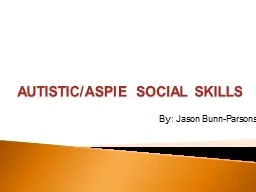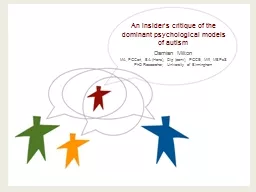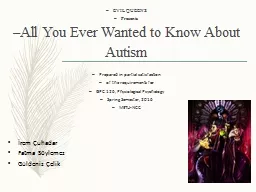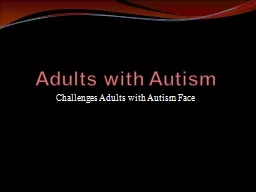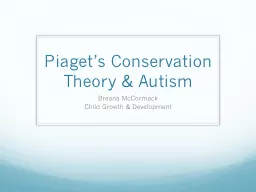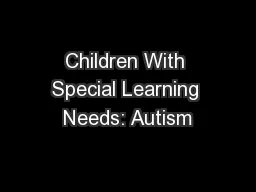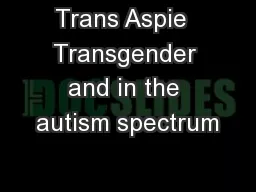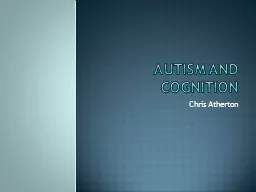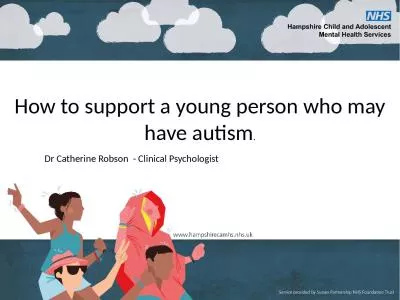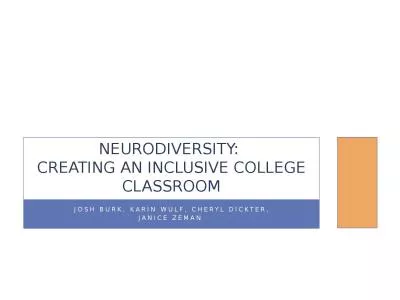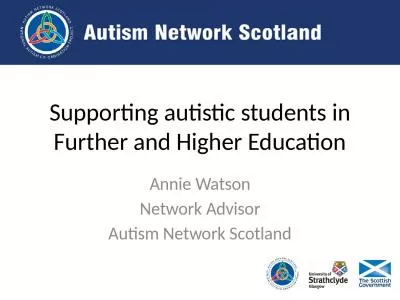PPT-Autistic/ASPIE Social
Author : liane-varnes | Published Date : 2020-04-03
Skills By Jason BunnParsons My 1 Point of Emphasis About AutisticAspies AutisticsAspies are 1 st and Foremost Human Beings AutisticsAspies have as all human beings
Presentation Embed Code
Download Presentation
Download Presentation The PPT/PDF document " Autistic/ASPIE Social " is the property of its rightful owner. Permission is granted to download and print the materials on this website for personal, non-commercial use only, and to display it on your personal computer provided you do not modify the materials and that you retain all copyright notices contained in the materials. By downloading content from our website, you accept the terms of this agreement.
Autistic/ASPIE Social : Transcript
Skills By Jason BunnParsons My 1 Point of Emphasis About AutisticAspies AutisticsAspies are 1 st and Foremost Human Beings AutisticsAspies have as all human beings do the same . 8/07/2014. Autistic Spectrum . Dis. . Order. Overcapacity. To the optimist, the glass is half full. . To . the pessimist, the glass is half empty to an Autistic, the glass is twice as big as it needs to be. dominant psychological models. of autism . Damian Milton . MA, . PGCert. , BA (. Hons. ), Dip (. conv. ), PGCE, . Mifl. , . MBPsS. PhD Researcher, University of Birmingham. Introduction. Critique of current psychological models regarding . Presents. All You Ever Wanted to Know . About. Autism. Prepared in partial satisfaction . of the requirements for . GPC 126, Physiological Psychology. Spring Semester, 2016. METU-NCC. İrem Çuhadar. Challenges Adults with Autism Face . Stats . Autism accounts for about 1% of the US Population . 1 out of every 68 children have a form of Autism . Right now 3.5-4 million people in the USA have Autism . Breana McCormack. Child Growth & Development. Jean Piaget. Born in 1896 . in Neuchâtel, . Switzerland. Died in 1980. Studied . at the University of Neuchâtel and briefly at University of Zurich.. Autism. In its purest form the definition of autism . is a mental condition, present from early childhood, characterized by great difficulty in communicating and forming relationships with other people and in using language and abstract concepts. Special usage: a mental condition in which fantasy dominates over reality, as a symptom of schizophrenia and other disorders.. ASK . As with any of my programs, ASK questions. Or comment. Or this will get boring!. If it gets boring A it is your fault or B tell me to get to the good part (assuming there is one). Why Autism Spectrum . Autism Prevalence. New prevalence rates emerging. 1/100 in United Kingdom. National Autistic Society. Five fold increase in the 1990s – . plateaued. by early 2000s (Taylor et al., 2013). 1/68 in United States. 160 of Autism Spectrum Disorders in the United States Danielle N. Martin East Carolina University Faculty Mentor: Michael Bassman East Carolina University ABSTRACT This paper aims to examine the com .. Dr Catherine Robson - . Clinical Psychologist. National Autistic Society . www.autism.org.uk. . Autism Hampshire. www.autismhampshire.org.uk. Barnados. Specialist Parenting Support. Hampshire Specialist Parenting Support Service | Barnardo’s. , . Cheryl . dickter. ,. Janice . zeman. . Neurodiversity. : . creating an inclusive college classroom. What is . Neurodiversity. ?. Neurodiversity. is a philosophy that emphasizes differences in human . Annie Watson. Network Advisor. Autism Network Scotland. Autism Network Scotland:. A . hub of impartial and reliable information . about autism. Signposts. individuals on the autistic spectrum, their families and carers & practitioners to local services. What is Autism?. Autism is a . hidden disability. . A . hidden disability . is a disability that you can’t see. . . Some Autistic people carry something with this pattern on it. Like on a wristband, card or mobile phone. . About me. Senior. Branch Engagement Officer (North of England). I support volunteer-led. . branches. of the charity across the North of England, including:. North Northumberland branch. Hexham. branch.
Download Document
Here is the link to download the presentation.
" Autistic/ASPIE Social "The content belongs to its owner. You may download and print it for personal use, without modification, and keep all copyright notices. By downloading, you agree to these terms.
Related Documents

